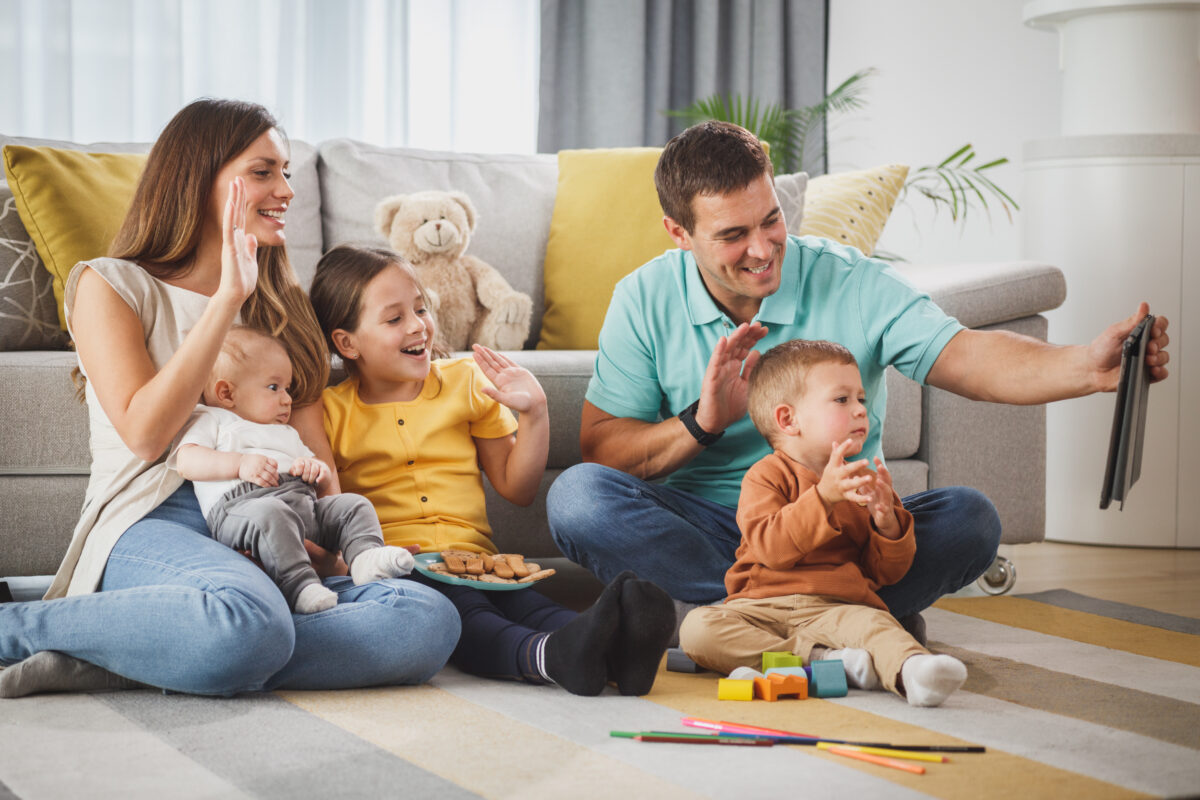
Every busy parent knows how great tablets and smartphones are for keeping kids entertained. Tech is a wonderful part of our world but, like all good things, needs to be part of a balanced lifestyle.
One of the thresholds we must cross as modern-day parents are when to let our kids loose on their very own devices.
Both tablets and smartphones open the same doorway to a digital world that’s inhabited by 4 billion strangers – so parents should approach and treat them just the same.
Smart devices are smart
Yes, we all love them! And our world is increasingly built around and dependent on them, for many reasons:
Safety
Needing to stay connected to your kids and know where they are at all times is a reality of our times. While security, safety, and convenience are the main reasons to consider getting your child a cell phone, there are other benefits too.
Education
Smart devices, with their ability to host interactive media, offer kids the opportunity to learn while playing, making it easier to acquire math, language and other skills.
Responsibility
Smart devices are expensive! They present an opportunity to teach kids a sense of responsibility and how to manage costs.
Social connection
Kids want to be where their friends are, and often, that’s online. In fact, they no longer think of an online and an offline world – to them, it’s all one world. In some ways, today’s kids are better connected than those of any other generation before them.
Entertainment
Smart devices are a one-stop TV, gaming console and music hub. Adding social media GPS, flashlight and camera functions means they’re actually used less and less for their original purpose: talking to people!
Smart devices need smart management
Our biggest challenge with the amazing tech surrounding us is how to control it rather than having it control us. With schools and families increasingly relying on tech, and the huge role that social media has been playing in connecting tweens and teens, there’s been a big impact on the mental health of young people.
Monitoring and guiding your kids as they go online, and helping them keep some balance with non-digital activities, is a huge part of parenting these days. Although life is busy and keeping up with what your kids are doing and seeing online is a never-ending task, it’s absolutely vital, given what they’re potentially exposed to with a tap or swipe of a finger.
Inappropriate content
Wherever your kids go in the digital world, the unfortunate reality is that they’ll come across age-inappropriate content. This includes exposure to extreme violence, pornography, self-harm and body-image issues, and ethnic or religious hatred. Blocking all this content requires the help of cutting-edge artificial intelligence – and even then, kids find ways to bypass parental restrictions.
Cyberbullying and strangers
From the work that Be in Touch does in schools, engaging tweens and teens to share what they are really seeing and doing online, cyberbullying is still a critical issue. It’s kept company by stranger contact and pornography, which are also key digital risks for this generation of kids.
Timesuck
We ourselves know how easily a couple of minutes of scrolling can become a black hole for time! Kids are even more susceptible to the lure of digital devices and the apps designed to pull them in and keep them there, often to the detriment of schoolwork, chores, exercise and family time. Don’t underestimate how addicting digital technology is for young, developing brains, particularly for children between 12 and 15.
Digital footprint
A smart device is a powerful search, communication and media-production tool. Kids can create text, images and videos that can be distributed widely and uploaded instantly, leaving a permanent trail that can come back to haunt them in later life. Smartphones have also become an easily accessible instrument for bullying, sexual harassment, and blackmail among children.
What age is the right age?
The right age to give your kids their first smart device is really up to you and is a very personal and individual decision. Age isn’t as important as your kid’s maturity level, ability to recognise boundaries and follow rules, sense of responsibility, and your own family’s needs. Parents really need to consider whether their kids are ready to use devices responsibly and respectfully and whether they have filters and controls in place to protect and monitor their kids as they start to go online.
Common Sense Media, an international non-profit organisation providing education and advocacy to families to promote safe technology and media for children, recommends giving thought to these questions:
- Do your kids show a sense of responsibility, such as letting you know when they leave the house?
- Do they show up when they say they will?
- Do your kids tend to lose things, such as backpacks or homework folders? If so, expect they might lose an (expensive!) phone, too.
- Do your kids need to be in touch for safety reasons?
- Would having easy access to friends benefit them for social reasons?
- Do you think they’ll use cell phones responsibly – for example, not texting during class or disturbing others with their phone conversations?
- Can they stick to limits you set for minutes talked and apps downloaded?
- Will they use text, photo and video functions responsibly, not to embarrass or harass others?
With electronic rehab, or “e-rehab”, now an accepted part of the response to digital addiction, some parents in the US have decided to take matters into their own hands by starting a non-profit organization called Wait Until 8th, encouraging parents to delay the age that children receive smartphones until eighth grade (when they’re around 12 or 13 years old). Their main arguments are that mobile devices are addictive, are an academic distraction, alter children’s brains, impair sleep, interfere with relationships, put children at risk of cyberbullying and sexual content, and greatly increase the risk for anxiety and depression.
Make no mistake, the pressure for smart devices starts earlier and earlier in primary school, and peer pressure makes it tougher for parents who want to delay the inevitable. But if you are able to stand firm until they turn 13, your kids will be so much better for it in the long run!

How do I help my child stay safe and sane?
Here are our top tips for parents looking to establish a healthy digital balance in their family:
Make informed family decisions
Does your tween really need a smartphone? Are there other options, like “dumb” phones, which will hold back the incoming tide of social media for a while until your child is emotionally mature, and you are ready for the parental monitoring responsibility that a smart device brings?
Loan rather than own
Be sure to position the smart device as something you are loaning to your child, and that they do not own it. This means you can negotiate how they interact with the device and what rules they must follow to continue to use it. Have a look at the Be In Touch Digital Family Alliance and Cell Phone Contract as resources to help you negotiate the loan of a smart device to your child.
Monitor, guide and talk
Teaching our kids how to use their devices safely is like teaching them how to drive: a structured learning process that involves giving them the knowledge, skills and confidence to go from being learner drivers to independent commuters who can safely navigate busy highways and byways.
Parental controls on devices are like bike helmets and safety belts: essential if you want to keep your kids safe and sane online. There is a range to choose from, but the most popular are parental controls like Bark which are designed to monitor rather than spy on kids, sending alerts on the issues that parents need to know about – like cyberbullying, online predators, depression, self-harm and body-image issues. These alerts are fundamental to those important conversations with your kids on navigating the online world.
Keep devices out of bedrooms at night
The stats show that nighttime is “prime time” for cyberbullying and stranger contact. Add tired young brains to the mix and you have a perfect storm for bad decision making! There’s also a strong correlation between evening and bedtime device use and sleep deprivation, which increases the risk of depression.
Getting your family into the habit of charging devices outside bedrooms at night is a small habit with a huge impact, including better sleep for developing brains.
Encourage real human connections
It might seem easier, but we can’t just say “no” to all smart devices used by teens. To give our teens the best chance of success as adults, we need to ensure that devices don’t replace extracurricular activities, family time and opportunities to connect with others face to face.
To develop interpersonal and social skills, teens need to interact socially and experiment with limited in supported environments – like chatting to that girl or boy they like, trying out for a team or a play, or joining a club or activity where they will meet new people. We need to encourage our teens to interact socially in person, so they develop the social intelligence they will need as adults.
Talk about FOMO vs JOMO
Ask your child if their device use is leaving them with a fear of missing out (FOMO) or the joy of missing out. JOMO is consciously choosing what makes you happy and being intentional about how you spend your time. It’s being fully present without worrying that you are missing out on something or how it will look on social media.
Teens are subjected to constant comparison and feeling left out during what are some of the most uncertain and vulnerable years of their lives. Even as adults, we can fall into the social media comparison trap, but we’re usually sufficiently confident and mature to be able to talk ourselves out of feeling too down when we see “perfect” posts on social media. We can’t totally shield our kids from feeling left out, but if we encourage more face-to-face interaction and activities, and talk to them about the need to limit social-media time, we might be able to protect them from constant comparisons and feeling excluded.
Talk about cyberbullying, stranger contact and pornography
Bullying has existed forever. What’s unique to this generation, however, is that our children are now vulnerable to constant bullying, wherever they are, with little effort and often few direct consequences. Talk to them about being both bullies (yes, even your kids!) and victims of bullying. Ask them if they know the difference between a bystander and an upstander. A bystander lets bullying happen around them (even in an online context), whereas an upstander calls bullying for what it is – hurtful, mean and not funny at all.
In the work that Be In Touch does in South African schools, 90% of learners report that nighttime is “prime time” for cyberbullying. The biggest impact that parents can have is to make sure that devices are out of bedrooms at night, limiting the opportunity for tired brains to make bad decisions!
With 73 of high school students reporting that they don’t know everyone who follows them on social media, and 62% reporting that they’ve been contacted by strangers online who send inappropriate messages or pictures, it is also clear that stranger danger online is an increasingly real risk. Talk to your kids about how to manage the settings on their social media apps so they can control who contacts and follows them, and how to manage unsolicited contact. Most of all, encourage them to talk to you when it happens!
Pornography is everywhere – on the internet, on social media, on gaming platforms and pop-up ads. It is highly addictive and fast becoming the new drug for this generation, making it a topic for family discussion that parents just cannot shy away from. In the absence of regulation, the burden is placed squarely on parental shoulders to protect their kids from exposure to online adult content which can affect brain development, relationships, beliefs and views. This is an impossible task without the help of parental controls.
Most of all, be in touch with your kids constantly as they go online. Now more than ever, this generation needs their parents to take ownership of their licence to parent!
The article was written for Discovery Health Mental Health Information Hub



